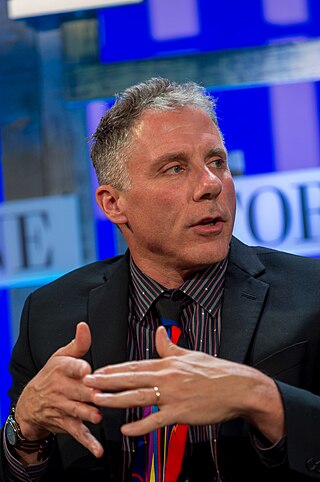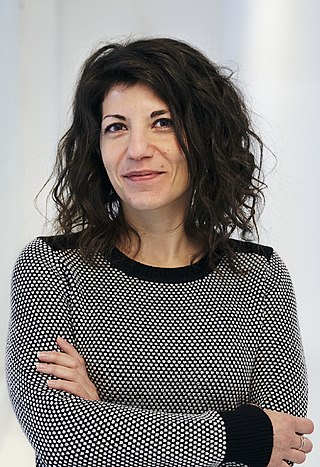Naomi J. Halas is the Stanley C. Moore Professor in Electrical and Computer Engineering, and professor of biomedical engineering, chemistry, and physics at Rice University. She is also the founding director of Rice University Laboratory for Nanophotonics, and the Smalley-Curl Institute. She invented the first nanoparticle with tunable plasmonic resonances, which are controlled by their shape and structure, and has won numerous awards for her pioneering work in the field of nanophotonics and plasmonics. She was also part of a team that developed the first dark pulse soliton in 1987 while working for IBM.

Armand Paul Alivisatos is a Greek-American chemist and academic administrator who has served as the 14th president of the University of Chicago since September 2021. He is a pioneer in nanomaterials development and an authority on the fabrication of nanocrystals and their use in biomedical and renewable energy applications. He was ranked fifth among the world's top 100 chemists for the period 2000–2010 in the list released by Thomson Reuters.

Nanochemistry is an emerging sub-discipline of the chemical and material sciences that deals with the development of new methods for creating nanoscale materials. The term "nanochemistry" was first used by Ozin in 1992 as 'the uses of chemical synthesis to reproducibly afford nanomaterials from the atom "up", contrary to the nanoengineering and nanophysics approach that operates from the bulk "down"'. Nanochemistry focuses on solid-state chemistry that emphasizes synthesis of building blocks that are dependent on size, surface, shape, and defect properties, rather than the actual production of matter. Atomic and molecular properties mainly deal with the degrees of freedom of atoms in the periodic table. However, nanochemistry introduced other degrees of freedom that controls material's behaviors by transformation into solutions. Nanoscale objects exhibit novel material properties, largely as a consequence of their finite small size. Several chemical modifications on nanometer-scaled structures approve size dependent effects.

Harry Albert Atwater, Jr. is an American physicist and materials scientist and is the Otis Booth Leadership Chair of the division of engineering and applied science at the California Institute of Technology. Currently he is the Howard Hughes Professor of Applied Physics and Materials Science and the director for the Liquid Sunlight Alliance (LiSA), a Department of Energy Hub program for solar fuels. Atwater's scientific effort focuses on nanophotonic light-matter interactions and solar energy conversion. His current research in energy centers on high efficiency photovoltaics, carbon capture and removal, and photoelectrochemical processes for generation of solar fuels. His research has resulted in world records for solar photovoltaic conversion and photoelectrochemical water splitting. His work also spans fundamental nanophotonic phenomena, in plasmonics and 2D materials, and also applications including active metasurfaces and optical propulsion.

Louis Eugene Brus is an American chemist, and currently the Samuel Latham Mitchell Professor of Chemistry at Columbia University. He is the co-discoverer of the colloidal semi-conductor nanocrystals known as quantum dots. In 2023, he was awarded the Nobel Prize in Chemistry.
Luke Pyungse Lee is the Arnold and Barbara Silverman Distinguished Professor of Bioengineering, Biophysics, Electrical Engineering and Computer Science, at University of California, Berkeley. He is founding director of the Biomedical Institute for Global Health Research and Technology (BIGHEART) at the National University of Singapore.

Cheon Jinwoo is the H.G. Underwood Professor at Yonsei University and the Founding Director of the Center for Nanomedicine, Institute for Basic Science (IBS). As a leading chemist in inorganic materials chemistry and nanomedicine Cheon and his research group mainly focus on developing chemical principles for synthesizing complex inorganic materials and nanoprobes/actuators used in imaging and controlling of cellular functions within the deep tissue in living systems.

Nicola Ann Spaldin FRS is professor of materials science at ETH Zurich, known for her pioneering research on multiferroics.
Prashant Jain is an Indian-born American scientist and a professor of chemistry at the University of Illinois Urbana–Champaign where his research laboratory studies the interaction of light with matter, designs nanoparticle catalysts, and develops methods for mimicking plant photosynthesis. He is a Fellow of the American Association for the Advancement of Science and the Royal Society of Chemistry, a TR35 inventor, a Sloan Fellow, a PECASE recipient, a Royal Society of Chemistry Beilby medalist, and a top-cited researcher in chemical sciences.

Vicki Leigh Colvin is a professor of engineering and molecular pharmacology at Brown University, and has been selected as the next dean of the Louisiana State University College of Engineering. At Brown, she is the director of the Centre for Biomedical Engineering. Her work focuses on the synthesis and characterization of nanomaterials. She is a Fellow of the American Association for the Advancement of Science and the American Institute for Medical and Biological Engineering.

Sara E. Skrabalak is a James H. Rudy Professor at Indiana University. Skrabalak leads a research group in the department of chemistry which focuses on the development of new nanomaterials. She has an adjunct appointment in the department of intelligent systems engineering.
Sandra J. Rosenthal is the Jack and Pamela Egan Professor of Chemistry, professor of physics and astronomy, pharmacology, chemical and biomolecular engineering, and materials science at Vanderbilt University. She is a joint faculty member at Oak Ridge National Laboratory in the Materials Science and Technology Division and the director of the Vanderbilt Institute of Nanoscale Science and Engineering.

Maiken Mikkelsen is a physicist who won the Maria Goeppert Mayer award from the American Physical Society in 2017 for her work in quantum nanophotonics. She is currently the James N. and Elizabeth H. Barton Associate Professor of Electrical and Computer Engineering and an associate professor of physics at Duke University where she teaches ECE 891: internship and ECE 524: introduction to solid state physics. Mikkelsen is credited for many advancements in optoelectronics, nanophotonics, human health and the environment.
Uri Banin is an Israeli nanotechnologist and physical chemist and a professor at the Hebrew University of Jerusalem, currently holding the Alfred & Erica Larisch Memorial Chair at the Institute of Chemistry. He is recognized as one of the pioneers of nanoscience in Israel.

Yi Cui is a Chinese-American scientist specializing in the fields of nanotechnology, materials science, sustainable energy, and chemistry. Cui is Fortinet Founders Professor at Stanford University, where he also serves as a professor of materials science and engineering and of energy science and engineering. He is a Highly Cited Researcher in the fields of materials science, environment and ecology, engineering, and chemistry as of 2023. From 2020 to 2023, Cui was the director of the Precourt Institute for Energy, and since 2023 he has served as the inaugural faculty director of the Sustainability Accelerator in the Doerr School of Sustainability.

Raffaella Buonsanti (born 1981 in Matera, Italy) is an Italian chemist and material scientist. Her research is at the interface between materials chemistry and catalysis as she focuses on the synthesis of nanocrystals to drive various energy-related reactions, such as CO2 reduction. She is currently an associate professor at École Polytechnique Fédérale de Lausanne (EPFL) and director of the Laboratory of Nanochemistry for Energy located at EPFL's Valais campus.
Haimei Zheng is a Chinese-American materials scientist who is a senior scientist in Materials Sciences Division at the Lawrence Berkeley National Laboratory. She is an adjunct professor in Department of Materials Science and Engineering at the University of California, Berkeley. Her research considers the nucleation, nanoscale materials transformations, and dynamic phenomena at solid-liquid interfaces, which she studies by developing the advanced in situ electron microscopy techniques. She is a Fellow of the Materials Research Society.

Nir Tessler is the Barbara and Norman Seiden professor in the Faculty of Electrical and Computer Engineering and head of the Microelectronics and Nanoelectronics centers at the Technion - Israel Institute of Technology.
Teresa Pellegrino is an Italian chemist who is Professor of Chemistry at the Istituto Italiano di Tecnologia. Her research considers nanomaterials for biomedical applications. She was appointed Associate Editor of Nanoscale in 2022.

Shelley Claridge is an American chemist who is an associate professor of chemistry at Purdue University. Her research considers the design of nanostructured materials and better understanding their physical and chemical properties. She was awarded a Schmidt Science Polymaths Award in 2022 and the American Chemical Society Women Chemists Committee Rising Star Award in 2023.












